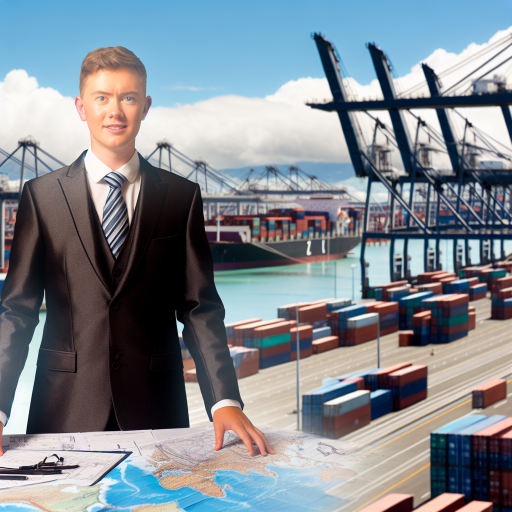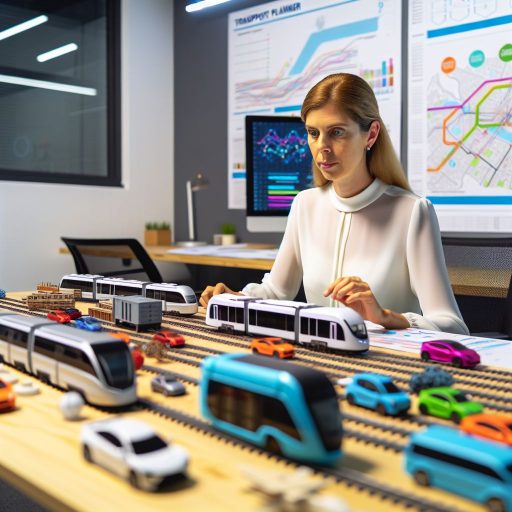Introduction
The transportation sector in New Zealand, particularly through the implementation of transportation automation, is essential for connecting communities and facilitating trade.
With a diverse landscape and growing population, efficient transportation becomes essential for economic development.
It supports businesses, enhances tourism, and improves overall quality of life.
Importance of efficiency in transportation for economic growth and sustainability
Efficiency in transportation contributes significantly to economic growth and sustainability.
A streamlined transportation system reduces costs, influences market accessibility, and fosters competition.
Thus, improved transportation directly correlates with enhanced productivity and innovation.
In recent years, automation has emerged as a transformative force within the transportation sector.
Innovations in technology streamline operations and enhance service delivery.
Automated systems improve logistics, reduce human error, and optimize resource allocation.
Smart technologies like IoT enable real-time tracking of goods and vehicles.
This allows for better route planning and faster response to disruptions.
Consequently, businesses can minimize delays and enhance customer satisfaction.
Furthermore, automated vehicles are revolutionizing public and freight transport.
These vehicles promise reduced congestion and improved safety.
As they gain acceptance, fewer accidents occur, resulting in safer roads for everyone.
Automation also drives sustainability efforts in the sector.
Efficient fuel usage and reduced emissions from automated systems align with New Zealand’s environmental goals.
As companies adopt cleaner technologies, they contribute to a greener future.
Moreover, automation addresses workforce challenges faced by the transportation sector.
While some fear job losses, automation also creates new opportunities.
Workers can transition to more skilled roles within the industry, emphasizing tech proficiency.
As New Zealand embraces automation, ongoing investment in infrastructure becomes critical.
Policy support and strategic partnerships fuel advancements in this area.
By prioritizing automation, New Zealand positions itself as a leader in efficient transportation.
Basically, the integration of automation into New Zealand’s transportation sector signifies a crucial step towards greater efficiency.
This transition not only fosters economic growth but also promotes sustainability, ensuring a robust and resilient future.
Current State of New Zealand’s Transportation Sector
New Zealand’s transportation sector serves as the backbone of its economy.
It connects communities, enables trade, and supports tourism.
This sector comprises several major modes of transport, each playing a crucial role in the economic landscape.
Overview of Major Modes of Transport
New Zealand’s transportation network consists of road, rail, maritime, and air transport.
Each mode has unique characteristics and contributions.
- Road Transport: This mode accounts for about 90% of domestic freight movement.
Road transport facilitates daily commutes and commercial logistics across regions. - Rail Transport: Rail transport covers long-distance freight and passenger services.
It connects key industrial areas, significantly reducing road congestion. - Maritime Transport: New Zealand’s maritime network is vital for international trade.
Ports serve as gateways, linking the country to global markets. - Air Transport: Air transport is essential for connectivity, especially for remote areas.
It supports tourism and freight transport, linking New Zealand to the world.
Breakdown of Employment and Economic Contributions
The transportation sector is a significant contributor to employment and economic growth in New Zealand.
- Employment: The sector employs thousands of New Zealanders, directly and indirectly.
Roles range from drivers to logistics managers and aviation personnel. - Earnings: Transportation jobs often offer competitive wages.
Many workers earn above the national average, contributing to local economies. - Economic Contribution: The transportation sector contributes billions to the GDP.
It plays a critical role in enabling trade and commerce nationwide.
Challenges Faced by the Sector
New Zealand’s transportation sector grapples with several pressing challenges.
These issues threaten efficiency and sustainability.
- Traffic Congestion: Major urban areas struggle with traffic congestion.
This results in lost productivity and increased emissions. - Aging Infrastructure: Many roads, bridges, and rail lines require significant repairs or upgrades.
Inadequate funding hampers maintenance efforts. - Labor Shortages: The sector faces significant labor shortages.
The demand for logistics professionals and drivers often outpaces supply.
Addressing these challenges is essential to enhance the effectiveness of New Zealand’s transportation system.
Automation emerges as a game-changing solution that promises to address these issues effectively.
Understanding Automation in Transportation
Automation in transportation represents a significant shift from traditional methods.
It involves employing technology to perform tasks with minimal human intervention.
This section explores the definition, components, examples, and historical impact of automation in transportation.
Personalized Career Consulting
Unlock your potential with expert career advice tailored to your goals. Get personalized guidance and actionable steps toward your dream career in New Zealand.
Get StartedDefinition of Automation and Its Components
Automation refers to the technology that reduces human involvement in tasks.
This process integrates various components, including:
- Artificial Intelligence (AI): AI enables machines to learn and make decisions.
It processes data and manages transportation systems efficiently. - Robotics: Robotics refers to machines designed for performing specific tasks.
Robotic systems facilitate transport operations, such as cargo handling and maintenance. - Internet of Things (IoT): IoT connects devices through the internet.
It allows real-time monitoring and communication among transportation entities.
Examples of Automation Technologies Utilized in Transportation
New Zealand’s transportation sector increasingly embraces automation technologies.
Here are some key examples:
- Autonomous Vehicles: Self-driving cars and trucks navigate roads with minimal human input.
They utilize AI algorithms and sensors to ensure safety and efficiency. - Traffic Management Systems: Smart traffic lights adapt to real-time traffic conditions.
They optimize traffic flow and reduce congestion, enhancing urban mobility. - Drone Delivery Services: Drones facilitate the swift delivery of goods.
They leverage GPS and IoT for navigation and monitoring. - Predictive Maintenance: IoT sensors on vehicles collect data.
Maintenance teams can address issues before they become critical, thus enhancing reliability. - Fleet Management Software: Automated systems help fleet operators track vehicles.
They optimize routes, monitor performance, and manage logistics effectively.
Brief History of Automation’s Impact on Transportation Globally
The journey of automation in transportation spans several decades.
Here is a brief overview:
- 1950s: Automated toll systems emerged, reducing cash-handling delays at toll booths.
- 1980s: Automated guided vehicles (AGVs) revolutionized materials handling in warehouses.
- 1990s: Traffic management systems introduced sensors and cameras for monitoring traffic flow.
- 2000s: Major companies began testing autonomous vehicles on public roads.
- 2010s: Ride-sharing apps utilized automation to seamlessly connect drivers and passengers.
Automation significantly influences global transportation.
Businesses and governments recognize its potential for increased efficiency and safety.
As automation evolves, it enhances productivity and minimizes costs.
Transportation companies leverage advanced technologies to address modern challenges.
They respond to urbanization, environmental responsibility, and consumer expectations.
These technologies pave the way for smarter, cleaner, and more efficient solutions.
Automation provides numerous advantages, including:
- Operational Efficiency: Streamlined processes improve delivery times and resource utilization.
- Safety: Automation reduces human error, leading to safer operations.
- Customer Satisfaction: Enhanced services boost competitive edge.
Overall, automation reshapes transportation in New Zealand and beyond.
The integration of AI, robotics, and IoT fosters innovative solutions.
These advancements tackle long-standing industry issues and create growth opportunities.
As the world embraces automation, adaptation becomes essential.
Transportation players must stay updated on technological developments.
Continuous learning and investment in automated systems lead to sustainable improvements.
In fact, automation holds vast potential for transforming transportation.
Its benefits include increased efficiency, reduced costs, and enhanced safety.
Embracing automation will be crucial for the future of transportation systems.
Read: In-Demand Logistics Jobs in NZ You Can Start Today
Case Studies: Automation in Action
New Zealand’s transportation sector has embraced automation in various forms.
Innovative companies and public initiatives have implemented automation strategies that enhance efficiency and service quality.
Overview of Successful Automation Implementations
Several sectors within New Zealand’s transportation system have adopted automation.
The following areas showcase the successful use of technology:
- Freight Logistics: Many logistics companies have integrated automated systems.
This includes warehouse automation and real-time tracking. - Public Transit Systems: City councils have implemented automated ticketing systems.
These systems streamline passenger experiences and reduce boarding times. - Traffic Management: Communities utilize automated traffic signals.
This technology adjusts signals based on real-time traffic flow, improving congestion.
Specific Case Studies
Below are detailed case studies of specific companies and initiatives that have successfully integrated automation into their operations:
Mainfreight: Automated Logistics
Mainfreight, a leading logistics company in New Zealand, has implemented automated warehouse systems.
These systems include robotic palletizers and automated guided vehicles (AGVs).
Transform Your Career with a Professional CV and Cover Letter
Stand out to employers with an ATS-optimized resume and tailored cover letter designed to match your dream role. Let us craft your job application materials for success!
Get Started- Robotic Palletizers: Automatically stack goods onto pallets.
This technology minimizes human error and speeds up the packaging process. - Automated Guided Vehicles (AGVs): Transport goods within warehouses.
AGVs follow predefined paths, ensuring efficient movement and reducing labor costs. - Real-Time Tracking Systems: Allow customers to monitor shipments online.
This transparency enhances customer satisfaction and improves service delivery.
The results have been impressive. Mainfreight has reported a significant reduction in operational costs.
Their warehouse efficiency increased, and customer satisfaction levels soared.
Auckland Transport: Smart Ticketing Systems
Auckland Transport has introduced an automated smart ticketing system for public transport.
This system allows passengers to pay for rides using contactless cards or mobile applications.
- Contactless Payments: Streamlines the boarding process, reducing wait times.
Passengers touch their cards on readers for instant access. - Automated Fare Calculation: Ensures fair pricing based on distance traveled.
This accuracy improves revenue generation for the transport network. - Data Collection: The system gathers usage statistics, aiding in service planning.
This information helps authorities enhance route efficiency.
Since implementing these systems, Auckland Transport has experienced a surge in ridership.
They report an increase in on-time performance and reduced operational strain during peak hours.
Wellington City Council: Smart Traffic Management
The Wellington City Council has deployed automated traffic management systems.
These systems monitor and control traffic signals based on real-time conditions.
- Adaptive Signals: Adjust red and green light cycles automatically.
This technology responds to live traffic data for better flow. - Integrated Surveillance Cameras: Monitor traffic patterns.
These cameras provide data to adjust signals and improve overall traffic management. - Emergency Vehicle Priority Systems: Allow emergency vehicles to pass through signals favorably.
This innovation enhances response times during critical situations.
The outcomes have been significant. Wellington has seen reduced traffic congestion and improved travel times.
Furthermore, the city’s automated systems have enhanced safety efforts by prioritizing emergency vehicles.
Analysis of Outcomes and Improvements
The integration of automation within New Zealand’s transportation sector has yielded numerous benefits.
Here are some key outcomes observed:
- Increased Efficiency: Automation has streamlined operations in logistics and public transport.
Companies can manage tasks quickly and with fewer errors. - Cost Savings: Businesses like Mainfreight have seen decreased labor costs.
Automation reduces the need for manual tasks, cutting long-term operational expenses. - Enhanced Customer Experience: Automated systems improve service delivery.
Passengers regularly report shorter wait times and seamless experiences. - Data-Driven Decisions: Automation provides valuable data insights.
Authorities and companies can plan better services based on usage patterns. - Environmental Benefits: More efficient logistics lead to reduced emissions.
Automated traffic systems decrease congestion, promoting greener transportation.
These improvements demonstrate automation’s promise in transforming transportation.
New Zealand stands at the forefront of using technology to enhance infrastructure and services.
Future Prospects and Challenges
While automation brings many advantages, some challenges remain.
The following factors require careful consideration:
- Investment Costs: Initial setup costs can be high for companies.
Businesses must calculate long-term financial benefits against these upfront expenses. - Skill Gaps: Automation can reduce the need for traditional jobs.
Workers may require upskilling to adapt to new technologies. - Cybersecurity Risks: Automated systems are vulnerable to cyber-attacks.
Companies and government must invest in robust security protocols. - Regulatory Frameworks: As automation evolves, regulations must keep pace.
Authorities need to develop guidelines for safe and ethical implementations.
In general, New Zealand’s transportation sector is leveraging automation to drive efficiency and enhance services.
Successful case studies illustrate the positive impact of automation across various transportation domains.
As technology continues to advance, it holds the potential to revolutionize the industry while addressing challenges thoughtfully.
Read: Flight Attendant Retirement in NZ

Benefits of Automation in Transportation
As New Zealand embraces automation, the transportation sector is experiencing remarkable transformations.
Automation enhances efficiency and reduces operational costs.
This technological advancement streamlines operations, minimizes human error, and promotes sustainability.
Below, we will explore the numerous benefits that automation brings to New Zealand’s transportation landscape.
Increased Efficiency and Reduced Operational Costs
One of the primary advantages of automation is increased efficiency.
By automating tasks, transportation companies can process operations more swiftly.
For example, automated scheduling systems coordinate transports to minimize delays.
These systems analyze traffic patterns and weather data to optimize routes effectively.
Additionally, automation reduces labor costs.
Companies can reallocate human resources to more strategic roles.
This redeployment of staff allows for better skill utilization and increased productivity.
As a result, operational costs decrease significantly, enabling firms to invest in other areas of their business.
Moreover, automated maintenance systems monitor vehicle performance continuously.
These systems track wear and tear on vehicles, predicting when repairs are needed.
This proactive approach prevents breakdowns, reduces downtime, and extends the life of transportation assets.
Boost Your Career with a Standout LinkedIn Profile
Attract recruiters and expand your network with a fully optimized LinkedIn profile tailored to highlight your strengths and professional goals. Let your profile open doors to new opportunities!
Get OptimizedEnhanced Safety Through Reduced Human Error
Safety is paramount in the transportation sector.
Automation reduces human error, which is a significant factor in accidents.
Self-driving technologies eliminate common mistakes made by human drivers, such as distractions and fatigue.
Autonomous vehicles use sensors and algorithms to navigate safely, responding to potential hazards in real time.
Furthermore, the implementation of automated safety systems significantly bolsters existing safety measures.
Technologies like automatic braking and lane-keeping assistants help prevent collisions.
These systems act quickly, often faster than human reflexes, improving overall road safety.
Training and operational consistency also improve through automation.
Human workers benefit from streamlined training processes focused on technology management rather than manual driving skills.
This consistency results in fewer accidents, contributing to safer transportation networks.
Improved Sustainability and Reduction of Carbon Footprints
New Zealand is committed to sustainability, and automation aligns perfectly with this objective.
Automated transportation systems often utilize electric or hybrid vehicles, reducing fossil fuel dependency.
This shift helps lower greenhouse gas emissions significantly.
Furthermore, automation promotes more efficient fuel usage.
Advanced routing software minimizes redundant trips, optimizing fuel consumption.
This efficiency leads to fewer emissions per mile traveled, benefiting the environment.
Smart logistics also play a crucial role in sustainability.
Automated systems analyze shipping routes to reduce energy consumption.
Using data analytics, companies can consolidate shipments, decreasing the number of trips and, in turn, reducing their carbon footprint.
Streamlined Processes Leading to Better Customer Service and Satisfaction
Customer satisfaction is vital in the transportation sector.
Automation enhances customer service through improved response times and streamlined processes.
Real-time data availability enables transportation companies to keep customers informed at all times.
Automated tracking systems offer real-time updates on shipment statuses.
Customers appreciate having access to this vital information, allowing them to plan accordingly.
This transparency fosters trust and enhances the overall customer experience.
Moreover, automated payment systems simplify transaction processes.
Customers can easily complete transactions through user-friendly interfaces.
This convenience leads to increased customer satisfaction and loyalty.
Companies that prioritize automation often reap significant benefits from positive customer feedback.
Furthermore, chatbots and automated customer service platforms provide round-the-clock support.
These systems offer instant responses to customer inquiries, improving service efficiency.
Customers value the availability of information and assistance at all times, leading to higher satisfaction rates.
Automation is reshaping New Zealand’s transportation sector, delivering numerous benefits.
Increased efficiency and reduced operational costs empower companies to thrive.
Enhanced safety through reduced human error protects lives and property.
Improved sustainability and reduced carbon footprints align with New Zealand’s environmental goals.
Additionally, streamlined processes lead to better customer service and satisfaction, building trust and loyalty.
As the transportation sector continues to adopt automation, New Zealand will undoubtedly enjoy a more efficient, safer, and sustainable future.
Embracing these changes will position the nation as a leader in innovative transportation solutions.
Read: Cultural Diversity in NZ Cabin Crew
Challenges and Concerns Related to Automation
As New Zealand’s transportation sector embraces automation, several challenges and concerns arise.
These issues require careful consideration to ensure a smooth transition into automated systems.
Stakeholders must work collaboratively to address each concern effectively.
Potential Job Displacement and Workforce Implications
One of the most pressing concerns revolves around job displacement.
Automation threatens to change the job landscape dramatically.
Many workers fear that their roles will become obsolete.
This concern is especially notable in professions reliant on manual labor.
- Drivers in public transportation may face reduced demand.
- Warehouse workers could see automation streamline their responsibilities.
- Logistics coordinators might find their roles evolving into technology management.
Moreover, the nature of skills required in the transportation sector will change.
Workers must adapt to new technologies and innovative systems.
Upskilling and reskilling will become essential for workforce sustainability.
Educational institutions should proactively develop training programs addressing these new demands.
Additionally, companies must navigate the social implications of widespread job loss.
Workers displaced by automation may struggle to find new employment within the sector.
Creating safety nets and support systems for affected workers represents a crucial step for employers.
High Initial Investment and Maintenance Costs for Automation Technologies
Implementing automation in transportation involves significant initial investments.
Companies need to consider the costs associated with purchasing new technology.
Furthermore, installing and integrating automated systems presents its own financial challenges.
- Advanced vehicles equipped with AI can incur high costs.
- Maintaining automated systems often requires specialized expertise.
- Upgrades and software updates demand ongoing financial commitments.
Small and medium-sized enterprises may face additional hurdles.
They might lack the financial resources necessary to invest in automation effectively.
Policymakers should consider incentivizing investments in automation, particularly for smaller firms, to promote equity in the sector.
While automation promises long-term savings, the high upfront expenditure can deter many organizations.
Thus, it is essential to provide comprehensive cost-benefit analyses.
This analysis should guide companies in making informed decisions about automation investments.
Public Perception and Acceptance of Automated Systems in Transportation
The successful integration of automation relies heavily on public perception.
Community acceptance plays a vital role in deploying automated transportation systems.
Many people remain skeptical about these technologies due to safety and privacy concerns.
- Fear of accidents involving autonomous vehicles can hinder acceptance.
- Concern about data privacy raises alarms for automated systems processing personal information.
- Lack of understanding about how automation works may foster resistance.
Public education campaigns can help address these issues.
Providing clear explanations about automation’s benefits is crucial.
Stakeholders need to demonstrate how automation improves safety, efficiency, and environmental impact.
Engaging communities in discussions about transportation automation fosters transparency.
Allowing citizens to voice their concerns can facilitate smoother implementation.
Building trust is essential for adopting automated solutions in New Zealand’s transportation sector.
Regulatory and Safety Concerns
Regulations governing transportation automation represent another significant challenge.
Current legal frameworks may not adequately address new technologies.
Policymakers must adapt existing rules or create new legislation to accommodate automated systems.
- Determining liability in accidents involving autonomous vehicles remains unclear.
- Safety standards need to evolve to incorporate automation features.
- Data security regulations should protect sensitive information gathered by automated systems.
In addition to legal considerations, ensuring public safety is paramount.
Testing and validating automated systems before deployment is crucial.
A robust regulatory framework can instill confidence in both consumers and businesses.
Collaboration among governmental agencies, industry leaders, and researchers is vital.
Working together can develop comprehensive guidelines that balance innovation and safety.
Public input should also contribute to crafting regulations that meet community needs.
New Zealand’s transportation sector is on the cusp of significant transformation through automation.
However, stakeholders must address the associated challenges and concerns diligently.
Each issue, from job displacement to regulatory frameworks, requires thoughtful consideration.
Through collaboration, education, and structured policy-making, New Zealand can navigate automation’s complexities.
The goal should always be to enhance transportation efficiency while ensuring community safety and workforce stability.
Read: Emergency Training for NZ Cabin Crew
Future Trends and Innovations in Transportation Automation
The transportation sector in New Zealand is on the cusp of remarkable transformation.
Emerging technologies promise to reshape its landscape significantly.
These innovations hold the potential for increased efficiency, safety, and sustainability.
As we look towards the future, it’s essential to understand the trends and innovations that will drive this sector forward.
Emerging Technologies on the Horizon
Several exciting technologies are emerging in the transportation automation landscape.
These trends include:
- Drone Delivery: Drones are becoming essential tools for logistics and delivery services.
They can transport goods quickly and efficiently over short distances.
New Zealand’s diverse geography makes drone delivery particularly beneficial.
It can reach remote areas that are challenging for traditional vehicles. - Electric Autonomous Vehicles: Electric vehicles (EVs) are crucial in reducing greenhouse gas emissions.
Automated EVs promise to streamline transportation, offering a safer and more efficient travel option.
With advancements in battery technology, the range and efficiency of these vehicles increase. - Smart Traffic Management Systems: Automation plays a crucial role in enhancing traffic management.
These systems utilize real-time data to optimize traffic flow.
They can reduce congestion and improve travel times significantly. - Connected Vehicle Technology: Vehicles that communicate with each other and infrastructure are revolutionizing the transportation sector.
This technology can enhance safety and improve navigation by providing real-time traffic updates. - Mobility-as-a-Service (MaaS): This concept integrates various transportation services into a single accessible platform.
It allows users to plan, book, and pay for multiple types of transport seamlessly.
MaaS enhances convenience and sustainability for everyday commutes.
Predictions on How Automation Will Reshape the Transportation Landscape in New Zealand
The impact of automation on New Zealand’s transportation landscape will be profound.
Predictions indicate several key changes:
- Increased Safety: Automation can drastically reduce the number of accidents on the roads.
With AI and machine learning algorithms, vehicles can make informed decisions faster than human drivers. - Improved Efficiency: Automated systems can optimize routes and schedules, minimizing wait times and fuel consumption.
This efficiency will lead to cost savings for both consumers and businesses. - Environmental Benefits: As automation progresses, the adoption of electric vehicles will likely rise.
This shift will reduce carbon emissions and contribute to the country’s sustainability goals. - Enhanced Public Transport: Automation can greatly improve public transport services, offering more reliable and efficient options for commuters.
It may encourage more people to use public transport rather than private vehicles. - Job Displacement and Creation: While automation may displace some jobs, it will also create new opportunities.
Roles in technology development, maintenance, and services related to automated systems will emerge.
Role of Government and Private Sector in Facilitating Automation Advancements
The successful implementation of automation in New Zealand’s transportation sector relies heavily on collaboration.
Both the government and private sector must play active roles in facilitating advancements.
This partnership will involve several key actions:
- Regulatory Frameworks: The government must create clear regulations that support innovation while ensuring safety.
These frameworks should address concerns related to data privacy and cybersecurity. - Investment in Infrastructure: Investing in the necessary infrastructure is vital.
This includes updating roads, traffic signals, and digital communication networks to support automated systems. - Public-Private Partnerships: Collaborations between government entities and private companies can accelerate the development of new technologies.
These partnerships can facilitate pilot programs and research initiatives. - Funding and Incentives: The government can provide funding and incentives for companies investing in automation technologies.
Grants or tax breaks can encourage innovation in this sector. - Education and Training Programs: Preparing the workforce for automation is essential.
The government and private sector should develop training programs that equip workers with the necessary skills.
In short, the future of transportation is bright with automation.
New Zealand stands at the forefront of this evolution, with emerging technologies set to redefine efficiency and safety.
The journey involves responsibilities shared between the government and the private sector.
Together, they can navigate the challenges and seize the opportunities that arise.
By embracing these advancements, New Zealand can lead the way for a sustainable and innovative transportation sector.
The commitment to fostering this transformation will be crucial as we prepare for the future of travel.
Strategies for Workforce Adaptation and Development
Importance of Training and Reskilling the Workforce for Automated Environments
The transformation of New Zealand’s transportation sector through automation has significant implications for the workforce.
As technologies evolve, the demand for new skills arises.
Ensuring the workforce is well-prepared for automated environments is crucial for success.
This approach enhances job security and fosters a culture of continuous learning.
In a rapidly changing job market, reskilling employees minimizes disruptions.
Here are key reasons why training and reskilling are essential:
- Adapting to New Technologies: Workers must understand how to operate advanced systems.
- Maintaining Productivity: A skilled workforce can maintain productivity during transitions.
- Preventing Job Displacement: Upskilling helps employees transition to new roles, reducing layoffs.
- Enhancing Job Satisfaction: Employees feel valued and engaged when they receive training.
- Meeting Industry Standards: Continuous training ensures compliance with evolving regulations.
Overview of Programs and Initiatives Aimed at Workforce Development in NZ
Recognizing the necessity of workforce development, New Zealand has taken proactive steps.
Various initiatives and programs aim to enhance skills across the transportation sector.
Collaboration between government and private enterprise plays a pivotal role in these efforts.
Funding and resources often support training and education opportunities.
Some notable programs include:
- The Future of Work Initiative: This government program focuses on preparing workers for jobs affected by automation.
- Industry Training Organisations (ITOs): These organizations provide training tailored to industry needs.
- New Zealand Qualifications Authority (NZQA): NZQA establishes standards for qualifications, ensuring relevance to current job markets.
- Apprenticeship Schemes: These programs encourage hands-on training in automated technology.
- Skill Integration Programs: Initiatives that integrate various skills needed for future roles in transportation.
Additionally, the government emphasizes partnerships with industry leaders.
Collaborations enable tailored training solutions.
This approach ensures relevance and direct applicability of what is learned.
These partnerships have proven effective in aligning workforce skills with industry needs.
Collaborations Between Educational Institutions and Companies for Skills Training
Educational institutions play a vital role in workforce development.
They collaborate with companies to ensure relevant skills training.
These partnerships foster a seamless transition from education to employment.
Moreover, they promote innovation within the curriculum to meet industry demands.
Some successful collaborations include:
- University-Industry Research Partnerships: These partnerships promote research that addresses real-world industry challenges.
- Internship and Co-op Programs: Students gain practical experience, enhancing their employability.
- Joint Degree Programs: These programs combine academic knowledge with industry skills.
- Workshops and Seminars: Companies offer training workshops to students and professionals.
- Industry Advisory Boards: Educational institutions establish boards with industry leaders to guide program development.
These collaborations result in a workforce that is agile and skilled.
They create pathways for continuous learning that benefit both employees and employers.
As a result, New Zealand’s transportation sector remains competitive and efficient.
Automation promises to transform New Zealand’s transportation sector significantly.
However, its success relies heavily on a well-trained and adaptive workforce.
Investing in training and reskilling initiatives is paramount.
Collaborative efforts between educational institutions and businesses further strengthen this approach.
Together, they will ensure a skilled workforce ready for the challenges of automation.
By prioritizing workforce development strategies, New Zealand can lead in transportation efficiency and innovation.
Embracing automation while preparing the workforce will yield positive outcomes for all stakeholders involved.
Conclusion
Automation greatly enhances New Zealand’s transportation sector.
It streamlines operations, reduces costs, and improves safety.
Automated systems accelerate freight movement and optimize route planning.
As a result, businesses gain efficiency and deliver services faster.
Consumers experience shorter wait times and lower prices.
This efficiency boosts economic growth and strengthens competitiveness in the global market.
However, the transition to automation presents challenges.
Job displacement remains a major concern for workers.
As machines take over more tasks, traditional roles may become obsolete.
It’s crucial for stakeholders to address these workforce issues.
Upskilling and reskilling initiatives can help affected employees adapt to new roles.
Moreover, regulatory frameworks must evolve.
Policymakers need to establish guidelines for automated vehicles and systems.
These regulations should prioritize safety while allowing innovation.
Balancing these interests is essential for successful implementation.
While automation offers numerous advantages, it is not without its hurdles.
The transportation sector must develop strategies to navigate these complexities.
Stakeholders should foster collaboration between industry leaders, government agencies, and educational institutions.
This partnership can help create a roadmap for the future.
In essence, New Zealand’s transportation sector stands on the brink of transformation.
Automation provides a pathway to enhanced efficiency and growth.
Stakeholders must embrace innovation while remaining vigilant about workforce impacts.
By addressing these challenges, New Zealand can lead the way in smart transportation solutions.
The future is bright for those who adapt and innovate.
Let us cultivate an environment where the benefits of automation flourish.
It is critical to invest in our workforce and infrastructure to achieve this vision.
Together, we can create a more efficient transportation system that benefits all New Zealanders.




